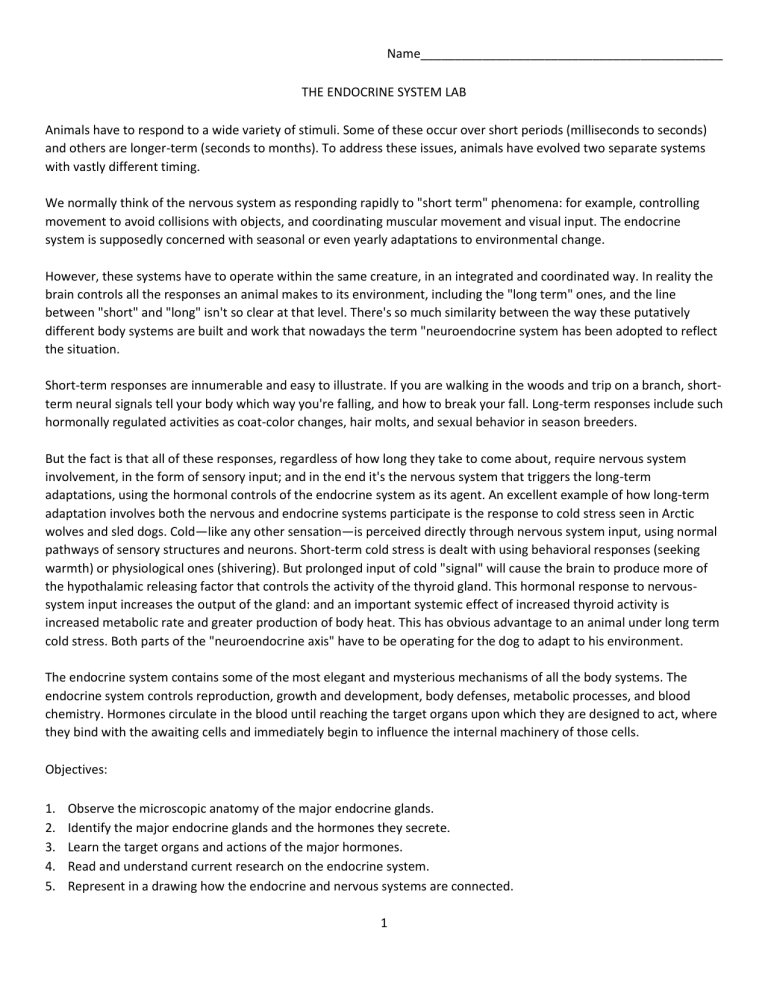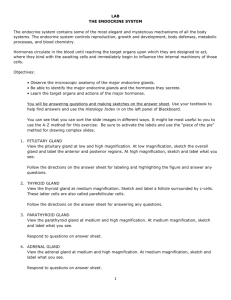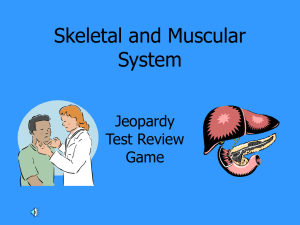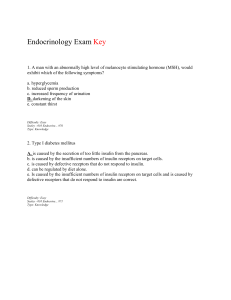Endocrine_Nervous-System-Lab

Name____________________________________________
THE ENDOCRINE SYSTEM LAB
Animals have to respond to a wide variety of stimuli. Some of these occur over short periods (milliseconds to seconds) and others are longer-term (seconds to months). To address these issues, animals have evolved two separate systems with vastly different timing.
We normally think of the nervous system as responding rapidly to "short term" phenomena: for example, controlling movement to avoid collisions with objects, and coordinating muscular movement and visual input. The endocrine system is supposedly concerned with seasonal or even yearly adaptations to environmental change.
However, these systems have to operate within the same creature, in an integrated and coordinated way. In reality the brain controls all the responses an animal makes to its environment, including the "long term" ones, and the line between "short" and "long" isn't so clear at that level. There's so much similarity between the way these putatively different body systems are built and work that nowadays the term "neuroendocrine system has been adopted to reflect the situation.
Short-term responses are innumerable and easy to illustrate. If you are walking in the woods and trip on a branch, shortterm neural signals tell your body which way you're falling, and how to break your fall. Long-term responses include such hormonally regulated activities as coat-color changes, hair molts, and sexual behavior in season breeders.
But the fact is that all of these responses, regardless of how long they take to come about, require nervous system involvement, in the form of sensory input; and in the end it's the nervous system that triggers the long-term adaptations, using the hormonal controls of the endocrine system as its agent. An excellent example of how long-term adaptation involves both the nervous and endocrine systems participate is the response to cold stress seen in Arctic wolves and sled dogs. Cold—like any other sensation—is perceived directly through nervous system input, using normal pathways of sensory structures and neurons. Short-term cold stress is dealt with using behavioral responses (seeking warmth) or physiological ones (shivering). But prolonged input of cold "signal" will cause the brain to produce more of the hypothalamic releasing factor that controls the activity of the thyroid gland. This hormonal response to nervoussystem input increases the output of the gland: and an important systemic effect of increased thyroid activity is increased metabolic rate and greater production of body heat. This has obvious advantage to an animal under long term cold stress. Both parts of the "neuroendocrine axis" have to be operating for the dog to adapt to his environment.
The endocrine system contains some of the most elegant and mysterious mechanisms of all the body systems. The endocrine system controls reproduction, growth and development, body defenses, metabolic processes, and blood chemistry. Hormones circulate in the blood until reaching the target organs upon which they are designed to act, where they bind with the awaiting cells and immediately begin to influence the internal machinery of those cells.
Objectives:
1.
Observe the microscopic anatomy of the major endocrine glands.
2.
Identify the major endocrine glands and the hormones they secrete.
3.
Learn the target organs and actions of the major hormones.
4.
Read and understand current research on the endocrine system.
5.
Represent in a drawing how the endocrine and nervous systems are connected.
1
You will be answering questions on the answer sheet and making sketches on a separate sheet of paper. Use your textbook and other resources to help find answers.
SLIDES TO VIEW, SKETCH, AND LABEL (on separate sheet of paper)
1.
PITUITARY GLAND. View the pituitary gland at low (100x) and high (400x) magnification. At low magnification, sketch the overall gland and label the anterior and posterior regions. At high magnification, sketch and label what you see at this magnification.
2.
THYROID GLAND. View the thyroid gland at low (100X) magnification. Sketch and label a follicle surrounded by ccells (parafollicular cells). C-cells produce calcitonin.
3.
PARATHYROID GLAND. View the parathyroid gland at (100x) and high (400x) magnification. Sketch and label what you see at both magnifications.
4.
ADRENAL GLAND. View the adrenal gland at low (100x) and high (400x) magnification. Sketch and label what you see at both magnifications.
GENERAL QUESTIONS
1.
Draw sketches of an exocrine gland and an endocrine gland and label them. State the name of the tissue from which they are derived.
2
2.
Label the endocrine glands in this diagram.
3.
Contrast steroidal and nonsteroidal hormones in terms of the biological molecules they are related to and their mechanisms of action on target cells. Give an example of each.
3
4.
Explain the action of a “second messenger” and give an example.
5.
In general, what is the function of the endocrine system?
4
6.
Explain a negative feedback system in five or six steps. What is positive feedback? When would this occur in the human body?
HYPOTHALAMUS
1.
The hypothalamus is an important link between the _____________________ system and the
____________________system.
2.
It receives ________________input about certain internal environmental conditions such as a.
___________________________ b.
___________________________ c.
___________________________
3.
What two hormones does the hypothalamus produce on its own?
5
4.
To what other endocrine structure does it connect?
PITUITARY
1.
For each target gland/tissue in the figure below, name the correct anterior pituitary hormone that acts on it.
2.
Name the two hormones secreted by the posterior pituitary and state their functions.
3.
Both the anterior and posterior pituitary glands release hormones, but the posterior pituitary is not a true endocrine gland. What is it?
6
4.
The pituitary is often referred to as a master gland, but what is its master? Describe the relationship between the pituitary and this other “master.’
PANCREAS
1.
State the exocrine function of the pancreas.
2.
Name and state the function of the three endocrine hormones of the pancreas and tell in what cells of the pancreatic islets they are located.
3.
What is the normal blood glucose range? How does the regulation of blood glucose relate to homeostasis? In other words, why is glucose homeostasis important chemically?
7
THYROID AND PARATHYROID
1.
Which hormone increases blood calcium levels? Where is it produced?
2.
Which hormone reduces blood calcium levels? Where is it produced?
3.
How are the thyroid and parathyroid glands linked anatomically?
4.
Where, specifically, do Americans obtain most of the iodine they need for proper thyroid function?
8
5.
To what does the Greek root “para” refer?
ADRENAL
1.
List the three hormones secreted by the adrenal cortex and the main functions of each. Which one do the gonads in men also secrete?
2.
List the two hormones of the adrenal medulla involved in the stress response.
9
3.
Potentially, what are five results of long-term stress?
4.
Read the Science News article below and summarize the connection between the nervous systems and the endocrine system as explained.
Science News Brain’s Support Cells Play Role in Hunger https://www.sciencenews.org/article/brain%E2%80%99s-support-cells-play-role-hunger
5.
On a separate sheet of paper or on the back of this page, make a concept map showing how the endocrine system connects to the cardiovascular system, the digestive system, the urinary system, and the nervous system.
10
11










